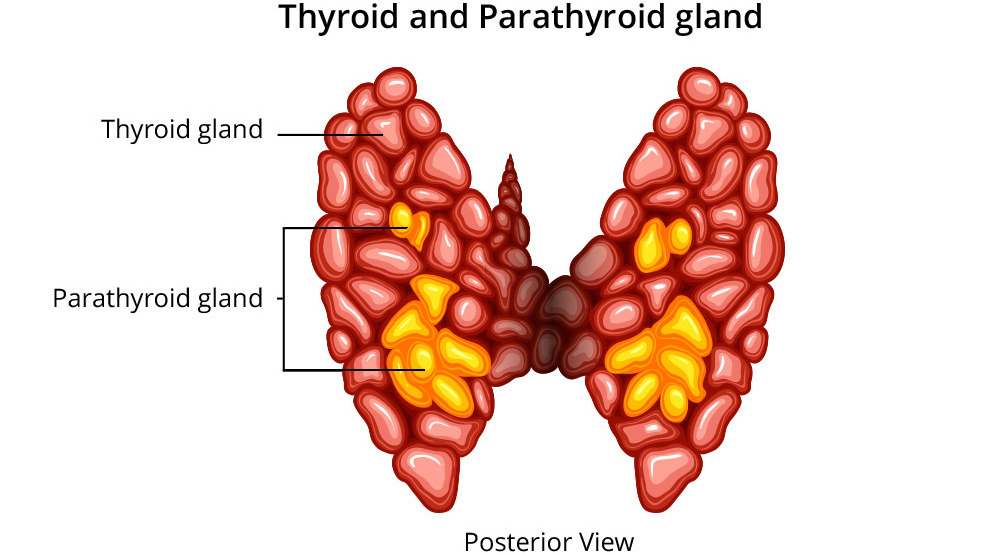An excess of parathyroid hormone releases calcium from bones and teeth. The consequences: bone loss and osteoporosis. What causes hyperparathyroidism?
The bio-logical chain is easy to understand: Hyperfunction of the parathyroid gland (hyperparathyroidism) leads to increased production of parathyroid hormone, which then releases more calcium from bones and teeth. In the long term, the lack of calcium leads to the breakdown of bone cells, bone loss in the long term and the diagnosis of ‘osteoporosis’ – but with a bio-logical meaning!
Why does hyperparathyroidism occur, and what is the bio-logical reason behind it?
It is not a mistake, fate or a fight against one’s own body, but an intelligent programme of nature that is activated in ‘emergency situations’ to ensure the survival of humans and animals. Each tissue has its own very precise and specific conflict issues – 100% identical and predictable in humans and animals.
The bio-logical conflict of the parathyroid gland: not being fast (muscular) enough to get ‘something’ or to get rid of ‘something’.
In nature, this ‘something’ represents a real ‘chunk’ for animals (air, oxygen, food, something necessary for life). For us humans, a ‘’chunk‘’ can be the following:
Examples ‘Not being able to get something’:
- Not being able to close a sale because someone else did the deal faster
- Not being able to buy a house because someone else was quicker
- Not getting the new job because I wasn’t quick enough
- Didn’t buy the share in time, too late again
- Didn’t get the partner of my dreams because the competition was quicker
Examples of ‘not being able to get rid of something’:
- Not being able to sell the house or securities quickly enough
- Not being able to run away from something or someone fast enough
- Not quitting your old job fast enough
- Staying in a toxic relationship for too long
In order for us to run, work and react faster, our body needs to increase its muscle activity. To increase this activity, our body needs more calcium. To increase the calcium level in the blood, the parathyroid gland produces more parathyroid hormone (hyperparathyroidism). This in turn releases calcium from our bones and teeth. A bio-logical chain reaction with a clear goal and bio-logical purpose – to finally get hold of the lump or get rid of it.

Normal parathyroid glands within the thyroid tissue

In order to produce more parathyroid hormone, the function of the parathyroid gland is increased, which later leads to cell proliferation

If the conflict is not resolved, it leads to ever-increasing cell proliferation in the long term (misdiagnosis of cancer)
The parathyroid gland consists of four paired glands that are located on the left and right side of the thyroid gland. Whether hyperfunction or later cell proliferation occurs on the left or right has a biological significance.
- Left side parathyroid gland with cell proliferation: wanting to get rid of something / ‘’chunks‘’
- Right side parathyroid gland with cell proliferation: Wanting to get something / ‘chunks’
The parathyroid gland belongs to the endodermal cotyledon. This results in:
- Conflict activity (the biologically perceived conflict is active): Hyperfunction and later cell proliferation (possible misdiagnosis of parathyroid carcinoma / cancer)
- Conflict-resolved phase = repair phase: temporary hypofunction and/or cell growth by fungal bacteria (pus production = selective tissue degradation)
Hyperfunction of the parathyroid gland results in cell proliferation
If the increase in function (= hyperfunction) in the conflict-active phase is not sufficient to resolve the biological conflict (too little muscular activity, not fast enough), the cells subsequently multiply. This additional production = cell proliferation = mitotic cell division makes bio-logical sense and is not a mistake of nature. More parathyroid hormone should be produced to release even more calcium from the bones and teeth. So they will finally be able to develop enough muscular activity and finally get or get rid of the lump.
Increasing calcium intake in cases of bone loss or osteoporosis makes no sense as long as the biological programme is still active. Only when the biological conflict has been resolved or weakened does it make sense to increase calcium intake again. So it can be effectively incorporated into bones and teeth with many other minerals involved (remineralisation).
This summarised description is intended to provide a quick overview in order to understand that intelligent programmes of nature intervene in a regulating way. If we resolve our perceived conflicts in a bio-logical and species-appropriate manner within a reasonable period of time, cell proliferation cannot occur. However, if we drag conflicts around with us or put them off, in the long term this leads to more and more tissue remodelling measures, which can then be misdiagnosed as ‘diseases’ or ‘cancer’. Animals in the wild usually resolve their conflicts in seconds, minutes or a few hours, which is why tumours and ‘cancer’ occur extremely rarely there.
Chronic processes: ‘Suspended healing’
If the specific conflicts are repeatedly activated with subsequent repair phases, specific tissue is increasingly transformed into scar tissue in the long term. The process is also known as suspended healing because the programme is repeatedly activated and never completed.
Conclusion:
Hyperparathyroidism is one possibility that can lead to bone loss and osteoporosis. A second possibility is an active self-esteem collapse that affects various areas of the bones and joints – more on this here: Bone complaints and joint pain have precise biological causes.


